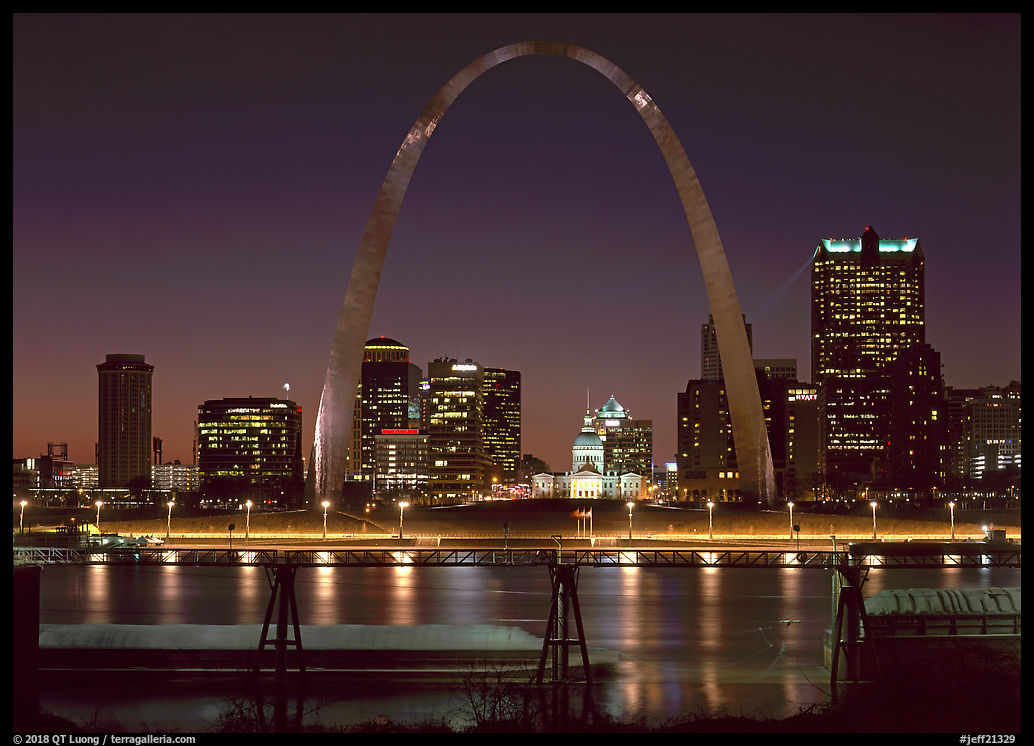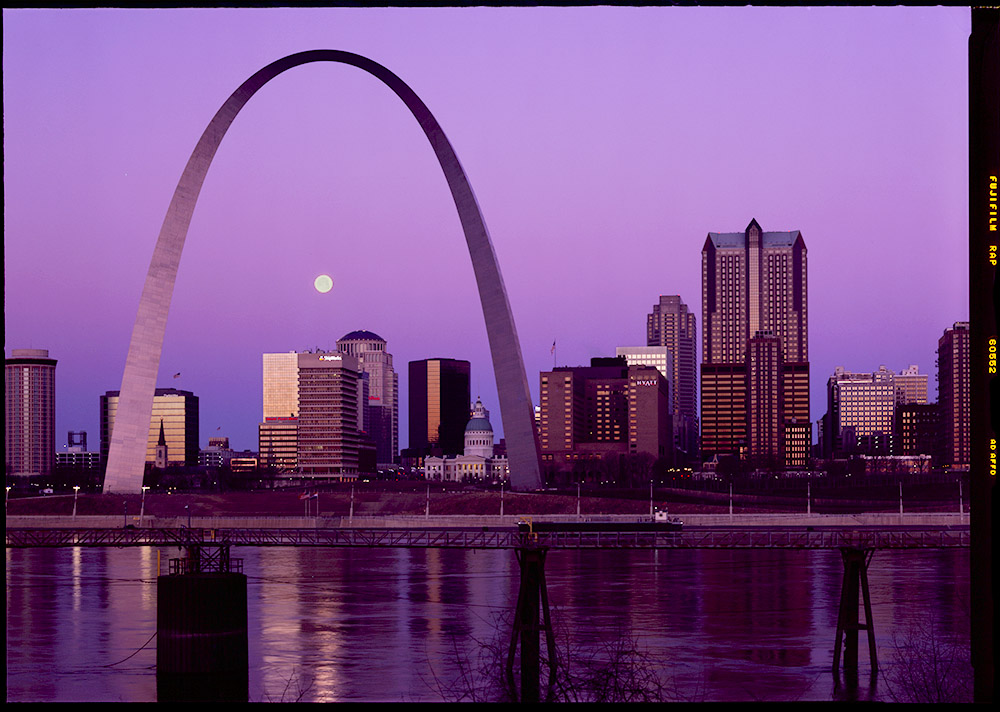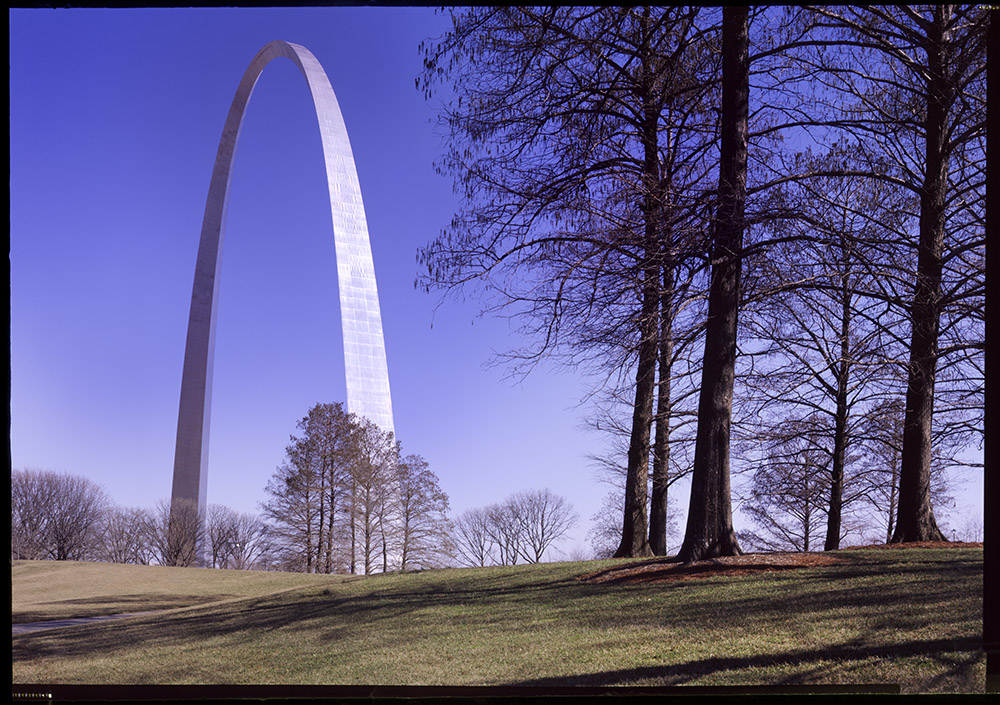Photographing Gateway Arch National Park
14 Comments
Thanks to my early visit to Gateway Arch National Park, it looks like as was the case for 58 and 59, I was the first to photograph the 60 national parks. This time it was only by a few days, as some of the people who had photographed the previous 59 national parks showed up less than a week later. On the other hand, my margin for being the first to do so on large format film is much larger, since to the best of my knowledge, nobody else had done it for the 59 previous national parks yet. Thank you to St Louis Magazine for reporting on my visit.
Challenging conditions for photography
This February trip had a drawback: the park was under construction. A major renovation is scheduled to be completed only this summer. Although most of the work is now taking place at the underground museum, the surface is full of temporary structures, signs, and fenced areas. When standing close to the Arch, I had to frame it against the sky to exclude them. For the large format photos, I prefer more context.

When you go further from the Arch on the park’s grounds, the North and South reflecting ponds, with their graceful curves mirroring that of the Arch, are an essential landscape feature. Usually, they are filled year-round, but because of the construction, they were drained.

From outside the grounds, there are two axial distant views available, both showing the Arch aligned with the Old Courthouse. One is from Kiener Plaza, west of the Old Courthouse. It features a sculpture called “the runner” located in a fountain that normally makes for a nice reflection pool. However, that fountain turned out to be drained for the season. It is filled only from about mid-March to November. By photographing from a distance, I avoided showing the empty fountain, but yet, that was not good enough to commit large format film.

The river view
The other distant view is across the Mississippi River. The official viewpoint there is the Mississippi River Overlook located in Malcolm W. Martin Memorial Park (85 W Trendley Ave, East St Louis, Illinois), open from 7AM to 10PM. The park, whose webpage is titled “BEST view of the Gateway Arch”, is also home to Gateway Geyser, the tallest water fountain in the U.S., capable of reaching a height of 630 feet, which matches precisely the height of Gateway Arch, with “eruptions” taking place daily at noon, May through September. The Mississippi River Overlook is a tiered accessible structure whose 40-ft height provide a view of the Mississippi River and St Louis Skyline, with the Arch and Old Courthouse in perfect alignment. The driving distance from the Arch to the Overlook via the Eads Bridge is about 2 miles one-way, but if you walk, you can save half a mile by taking the ramp and elevator from the bridge to the street via the East Riverfront Station.

Unfortunately, the photographs taken from the Mississippi River Overlook are marred by power lines, especially at daytime. Not a big problem in the digital age, but to stay faithful to my practice of not digitally removing elements from photographs, I found alternative views along the river. The city has a plan to transform the whole east shore area into a bird park with scenic views, doubling the surface area of the National Park, but this proposal had been floated for years and so far not much has happened.

Image A: River view, sunset
In the while, wandering the east shore of the Mississippi is problematic because of private property and the industrial activity centered around the large Cargill grain elevator. Trucks and freight trains on several railroad lines frequently ply the area, and a grain conveyor and dock used to load barges is located exactly opposite the Arch, intruding into views, such as this one with the Old Courthouse profiled against the sky rather than against a high-rise building.

Image B: River view, night
I went there four times, at midday, twice at sunset, and at dawn. I timed the later attempt for the full moon, the only day in the month when the moon can be photographed centered inside the arch at dawn. The day before, when the moon would reach the desired position, the landscape would be too dark compared to the moon, and the day after, the alignment would occur well past sunrise. Centering the moon in this photograph dictated yet a slightly different viewpoint.

Image C: River view, sunrise
The park view
I spent much time on the distant views because in them the construction is barely visible. To create a landscape photograph photographed from within the park that includes the Arch and its grounds, I had to avoid including the construction or the drained ponds, and find a viewpoint from which the Arch is not occluded by trees, and where the angle of view shows enough of its curved shape. I found only one spot that met all the criteria, just south of the Old Cathedral parking lot, where a small mound hid the Arch’s base.

Image D: Park view
I was hoping that because the park’s small size and limited natural resources, a single visit would be enough – unlike for the other national parks, which I have visited in average five times. However, a return to photograph the Arch with the filled reflecting ponds appears inevitable.
In the while, I need to choose an image to stand for Gateway Arch National Park in the updated Treasured Lands exhibit, which consists of one image for each national park. I’d be grateful if you could let me know which of the last four you prefer: A, B, C, or D and why. I will not be replying to comments so as not to influence your choices (I’ve already written too much!) but be sure that I read carefully and appreciate every one of them!
Update April 30, 2018: poll closed, results are here


I chose the park view, as it is the only one that carries on the spirit of the monument being the “Gateway to the West” rather than just a landmark plunked in a big city skyline.
I choose D as I don’t see that POV of the Arch often if ever. I really like the Park view.
All four photographs were beautiful. For me, it came down to either the sunset or sunrise shot. Ultimately, I picked the sunrise shot. The position of the moon makes the shot really unique – a sunrise shot looking west at a setting moon! Very cool! I also liked the fact that the sunrise shot had more light on the downtown buildings, especially the Old Courthouse. The buildings in the sunset shot were more “silouetted” against the sky. Again, that’s a nice shot, especially the orange sky. I just prefer the sunrise shot more. As always, thank you for sharing your amazing work!
I chose the sunrise view for the same reasons! Hard choice form such wonderful work – but sunrise just edged it
I chose Image D, the Park view because the arch is the only man made item in the photo, and my eye is immediately drawn toward it. The contrast between the man made Arch and the natural trees is very striking.
I chose D because of the trees. Besides contrasting with the man made Arch, the large specimens at the right allow the Arch to stand off-center (something like the rule of thirds), and the distant ones at the base provide a much needed sense of scale.
I chose C and D and pressed the button before I narrowed it down to one! The Park View is my favorite for its setting among hills and trees. I will most always choose natural environment over hardscape. However the sunrise (C) with the moon in the arch was spectacular. Thank you for sharing them both. Such a gift!
The Park View is iconoclastic, artful and even a bit edgy, which I love. All of Mr. Quong’s photos are beautifully composed, interesting and quite fabulous, begging the question “how did he do that?”. Thank you!
Sunrise C
Balance, symmetry and tonality. The resultant lighting on the arch gives it a three dimensional quality and provides an anchor for the viewers eye to come back to.
I chose (A) Sunset view. St. Louis as well as the Louisiana Purchase is anchored by the Mississippi River. The sunset represents the land toward the west which was the goal of the western settlers. The memorial anchors transportation modes of the Mississippi River to the westward bound trails leaving St. Louis.
Hard choice. All 4 are great. I like park view and sunrise. I chose sunrise because I know how difficult it is to catch the moon at just the right place and lighting. I shoot mostly 4 x 5 myself; only way to get good perspective.
All the pictures are great, but I am more than perplexed that this has been designated as a national park. As someone that aspires to photograph all of the parks as you have done, I am actually disappointed to hear the news. I am sure that the monument is awesome and I do want to see it, but this is a monument and not a full national park. Hot Springs gets a pass because of the history of how it became a park so long ago. I have visited Pinnacles many times and love the place, but was not in favor of it gaining National Park status either. What is wrong with just calling a monument a monument? Why can’t congress listen to the Park Service? They know what they are talking about.
where does this stop? Is Coney Island the next national park?
I chose the park view (D), because I think it’s important to show the arch in the context of its landscape. Otherwise, it just appears as a monument surrounded by buildings, and not part of a park.
I chose the sunrise view. I appreciate the planning on loved in capturing the moon in that position with that light. I also appreciate the less often seen perspective of image D